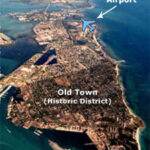Is Flying Really Safer Than Driving? Absolutely, commercial airline travel is statistically safer than driving a car, but general aviation presents a different picture. Find out more on flyermedia.net. This article dives deep into accident data, pilot error, and safety strategies, ultimately helping you understand aviation safety and make informed decisions to enhance flight safety, even in personal aviation.
1. Is Flying Safer Than Driving?
Commercial airline travel is statistically much safer than driving. However, the safety comparison between driving and flying shifts when considering general aviation (GA). Driving offers a lower risk profile overall.
To understand this, we must examine the data carefully. While commercial airlines have an incredibly low accident rate, general aviation, which includes private planes and personal flights, presents a higher risk. Factors such as pilot experience, aircraft maintenance, and flight conditions play crucial roles in determining the safety of a flight.
2. How Do Accident Rates Compare Between General Aviation and Driving?
General aviation accident rates are higher than those for driving, although comparing these rates requires a careful look at the metrics used. The fatal accident rate for personal GA flights is significantly higher than that of driving.
The National Highway Traffic Safety Administration (NHTSA) measures driving accidents per 100 million vehicle miles traveled. In contrast, the National Transportation Safety Board (NTSB) measures general aviation accidents per 100,000 flight hours. A 2020 study provided a solution, showing 0.6 to 0.7 fatal car crashes per million hours driven. According to the NTSB, there were 9.5 fatal GA accidents per million flight hours in 2021, approximately 14 times the driving fatality rate. For personal flights, this rate jumps to 21.1 fatal accidents per million flight hours, about 27 times the driving fatality rate.
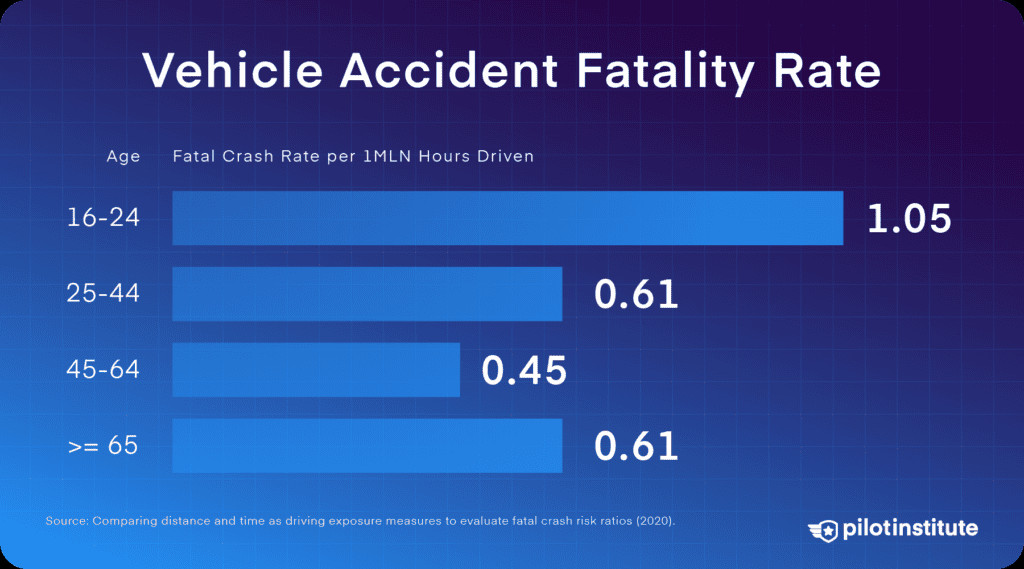 Vehicle accident fatality rate by age
Vehicle accident fatality rate by age
3. What Factors Make Personal Flights More Dangerous?
Personal flights have a higher accident rate due to various factors, including less stringent regulations, pilot experience, and aircraft maintenance. These flights account for a significant portion of general aviation accidents and fatalities.
Personal flights, such as leisure trips or short local flights, often involve less experienced pilots and aircraft that may not be maintained to the same standards as commercial or corporate planes. Additionally, personal flights may occur under a wider range of weather conditions, increasing the risk of accidents. Unlike commercial airlines, personal flights lack the structured environment and rigorous oversight that contribute to safer outcomes.
4. How Safe Are Instructional Flights Compared to Driving?
Instructional flights are safer than personal flights but still carry more risk than driving. The structured environment, supervised operations, and higher pilot proficiency contribute to a lower accident rate.
Between 2012 and 2021, instructional flights saw 2.3 fatal accidents per million flight hours, a 52% reduction since 2012. This makes flight training approximately 3.4 times more dangerous than driving, a notable improvement compared to personal flights. The presence of certified flight instructors, adherence to strict protocols, and well-maintained training aircraft all contribute to the enhanced safety of instructional flights.
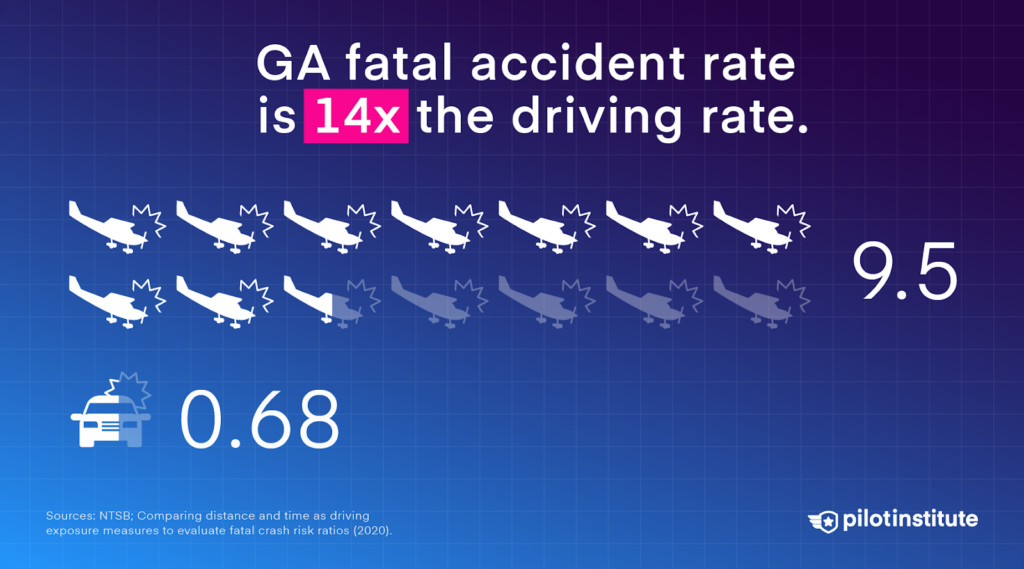 The GA fatal accident rate is roughly 14 times that of driving
The GA fatal accident rate is roughly 14 times that of driving
5. What Are the Primary Causes of Accidents in General Aviation?
The primary causes of accidents in general aviation include pilot error, mechanical failures, and other/unknown factors. Pilot error is the most significant contributor, accounting for a large percentage of all incidents.
According to the AOPA’s Richard G. McSpadden Report, pilot-related issues account for 69% of all GA accidents. Mechanical failures comprise about 16% of accidents, while other/unknown causes account for the remaining percentage. Understanding these causes is essential for developing strategies to mitigate risks and improve safety in general aviation.
6. How Does Pilot Error Contribute to General Aviation Accidents?
Pilot error is the leading cause of general aviation accidents, with loss of control in-flight being the most common and fatal defining event. Human factors, decision-making, and proficiency all play critical roles.
Pilot error encompasses a range of issues, including poor decision-making, inadequate flight planning, failure to maintain control of the aircraft, and insufficient training. Loss of control in-flight (LOC-I) occurs when the pilot fails to maintain the desired flight path and attitude, often due to stalls, spins, or uncoordinated maneuvers. The NTSB lists LOC-I as the most common cause of accidents and the most fatal.
7. What Role Do Mechanical Failures Play in GA Accidents?
Mechanical failures are the second most common cause of GA accidents, although they result in fewer fatalities compared to pilot error. Engine failures, fuel system issues, and structural failures are common mechanical problems.
Mechanical failures comprised about 16% of all accidents but only 7% of fatal ones in 2021. Engine failures are the most significant contributor to mechanical issues. Common issues such as fuel contamination, fuel starvation, and fuel exhaustion can also lead to accidents. About half of all engine failures are attributed to preventable factors involving pilots or maintenance, highlighting the importance of thorough pre-flight checks and regular maintenance.
8. How Can Pilots Prevent Mechanical-Related Accidents?
Pilots can prevent mechanical-related accidents through thorough pre-flight inspections, regular maintenance, and proper fuel management. Addressing preventable issues can significantly reduce the risk of mechanical failures.
Regular aircraft maintenance, adherence to inspection schedules, and prompt repair of any identified issues are essential. Pilots should also conduct thorough pre-flight inspections, checking fuel levels, fuel quality, and engine components. Proper fuel management, including accurate flight planning and monitoring fuel consumption, can prevent fuel-related accidents.
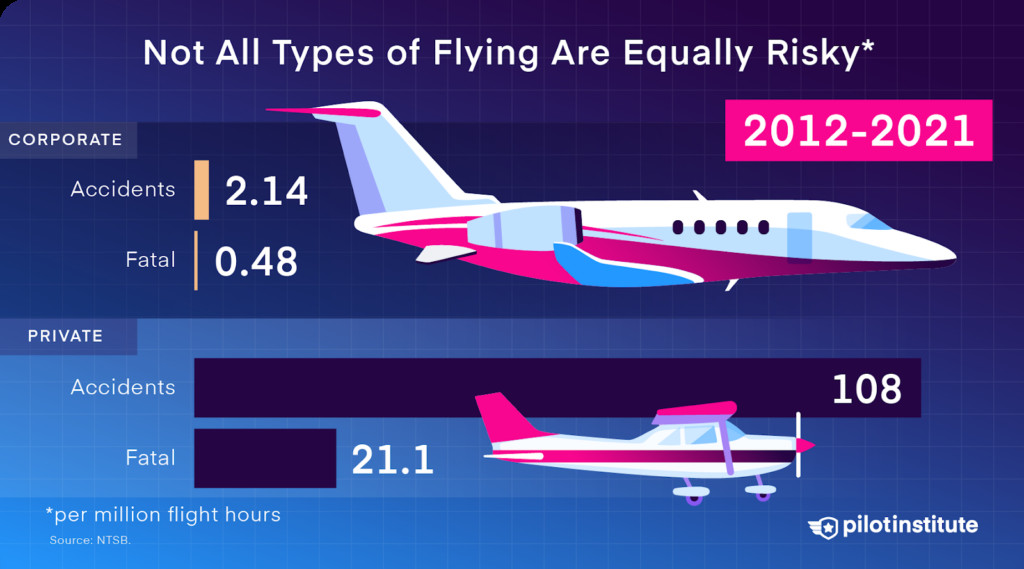 Corporate GA flying is quite safe compared to private flights
Corporate GA flying is quite safe compared to private flights
9. What Safety Measures and Best Practices Can Improve GA Safety?
Safety measures and best practices in general aviation include structured operations, rigorous training, proficiency, and risk management. Implementing these measures can significantly reduce the risk of accidents.
Flight schools, which have lower accident rates than personal flights, offer a model for enhancing safety. These schools maintain structured operations, emphasize risk aversion, maintain aircraft to high standards, and ensure instructors are highly proficient. Pilots can adopt a similar mindset by pursuing continuous training, adhering to strict protocols, and prioritizing safety in all aspects of flight.
10. How Can Risk Management Reduce Accidents in General Aviation?
Risk management involves identifying potential hazards, assessing risks, and implementing strategies to mitigate those risks. Proactive risk management is crucial for enhancing safety in general aviation.
Pilots should use tools such as the FAA Risk Assessment Matrix to evaluate potential hazards and make informed decisions about whether to fly. This includes considering weather conditions, aircraft maintenance, pilot fatigue, and other factors that could impact flight safety. By systematically assessing and mitigating risks, pilots can reduce the likelihood of accidents and improve overall safety.
 Personal flights account for the majority of total GA accidents and fatalities
Personal flights account for the majority of total GA accidents and fatalities
11. What Is Loss of Control In-Flight (LOC-I) and Why Is It So Dangerous?
Loss of control in-flight (LOC-I) is when a pilot loses the ability to maintain the desired flight path and attitude of the aircraft. This is a leading cause of fatal accidents in general aviation.
LOC-I can result from various factors, including stalls, spins, uncoordinated maneuvers, turbulence, and pilot incapacitation. Half of LOC-I accidents involve stalls and spins in the traffic pattern during maneuvering flight, which are seldom recoverable. Recovering from LOC-I requires immediate and correct action, which can be challenging in high-stress situations.
12. What Actions Can Pilots Take to Prevent Loss of Control In-Flight?
To prevent loss of control in-flight, pilots should maintain proficiency in basic flight maneuvers, understand aircraft limitations, and avoid risky situations. Regular training and adherence to best practices are essential.
Pilots should practice stall recovery techniques, maintain proper airspeed and altitude, and avoid abrupt or uncoordinated control inputs. Understanding the aircraft’s flight envelope and operating within its limitations is also crucial. Continuous training, including flight reviews and recurrent training, can help pilots maintain proficiency and prevent LOC-I.
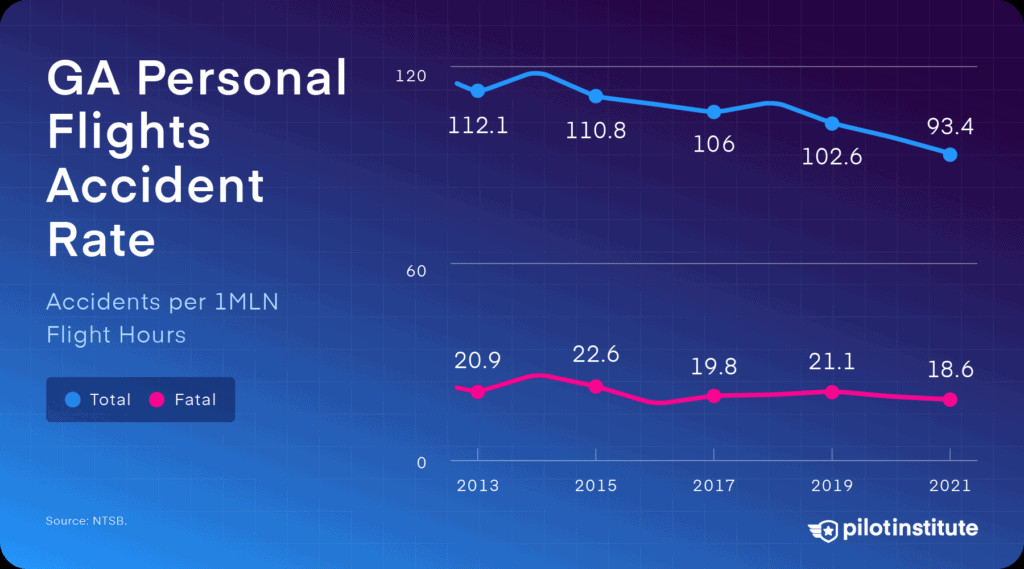 GA personal flights accident rate: 2012-2021
GA personal flights accident rate: 2012-2021
13. How Does Weather Contribute to Accidents in General Aviation?
Weather is a significant factor in general aviation accidents, especially unintended VFR flight into instrument meteorological conditions (IMC). Poor visibility, icing, and turbulence can lead to loss of control and other hazardous situations.
Unintended VFR flight into IMC had a 71% fatality rate in 2021. Flying visually into clouds or low visibility can quickly lead to disorientation and loss of control. Pilots should always obtain a thorough weather briefing before flight, assess the conditions along the route, and be prepared to divert or cancel the flight if necessary. Icing and turbulence can also significantly impact aircraft performance and control, requiring pilots to exercise caution and avoid these conditions whenever possible.
14. What Is Controlled Flight into Terrain (CFIT) and How Can It Be Prevented?
Controlled flight into terrain (CFIT) is an unintended collision with the ground or an obstacle, often resulting from a loss of situational awareness or attempts to push below minimums during instrument procedures.
Preventing CFIT requires maintaining situational awareness, using navigation aids effectively, and adhering to minimum altitudes. Pilots should always be aware of their position, altitude, and surrounding terrain. Using GPS, terrain awareness systems, and other navigation tools can help pilots maintain situational awareness and avoid CFIT. Never descend below minimum altitudes during instrument procedures, and always be prepared to execute a missed approach if necessary.
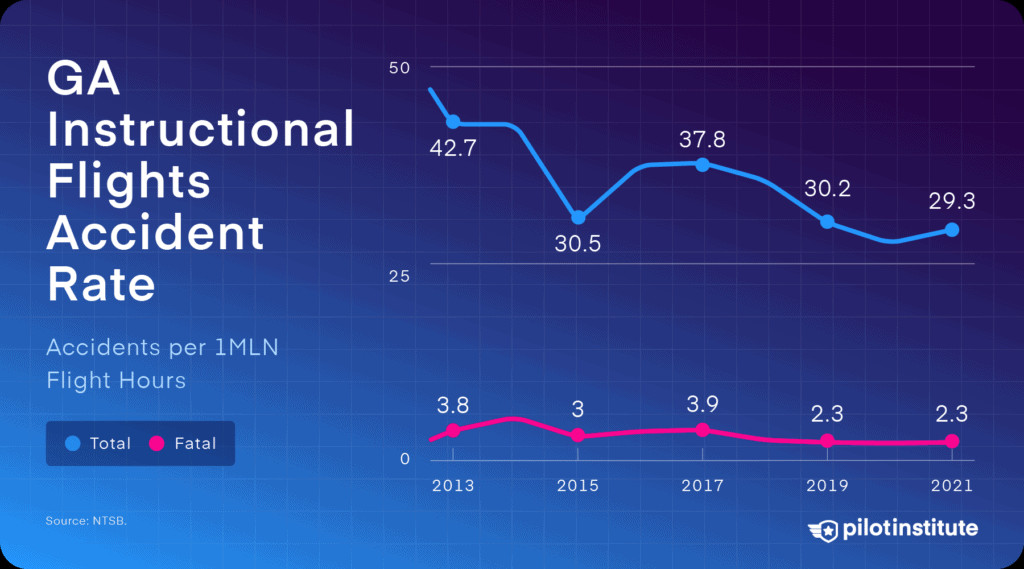 GA instructional flights accident rate: 2012-2021
GA instructional flights accident rate: 2012-2021
15. What Are the Key Elements of a Thorough Pre-Flight Inspection?
A thorough pre-flight inspection includes checking the aircraft’s exterior, interior, and engine components. This ensures that the aircraft is in safe working condition before each flight.
Pilots should inspect the aircraft’s exterior for any signs of damage, such as dents, cracks, or corrosion. Check control surfaces, landing gear, and tires for proper operation and condition. Inside the cockpit, verify that all instruments and systems are functioning correctly. Examine the engine for any leaks, check fluid levels, and ensure that all components are properly secured. A detailed pre-flight inspection can identify potential issues before they become hazardous during flight.
16. Why Is Continuous Training Important for General Aviation Pilots?
Continuous training is crucial for general aviation pilots because it helps maintain proficiency, enhances decision-making skills, and keeps pilots up-to-date with the latest safety practices and regulations.
Regular flight reviews, recurrent training, and participation in safety seminars can all contribute to continuous improvement. Training should focus on reinforcing basic flight maneuvers, practicing emergency procedures, and understanding advanced topics such as weather, navigation, and risk management. By investing in continuous training, pilots can enhance their skills, knowledge, and overall safety.
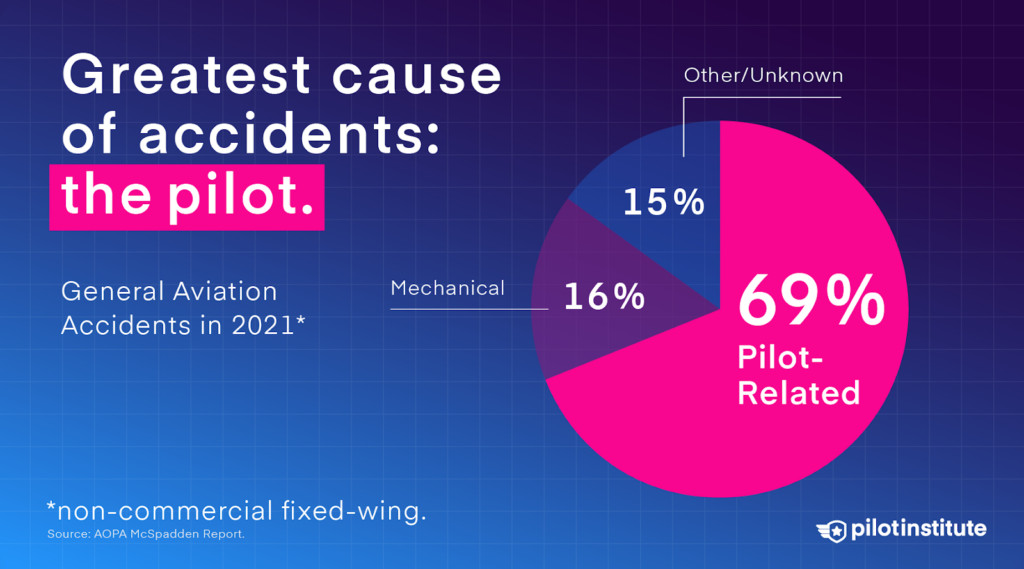 The greatest cause of GA accidents is the pilot
The greatest cause of GA accidents is the pilot
17. How Can Pilots Improve Their Decision-Making Skills?
Pilots can improve their decision-making skills by practicing risk management techniques, learning from accident case studies, and seeking feedback from experienced pilots and instructors.
Risk management involves identifying potential hazards, assessing risks, and implementing strategies to mitigate those risks. Use tools such as the FAA Risk Assessment Matrix to evaluate potential hazards and make informed decisions about whether to fly. Studying accident case studies can provide valuable insights into the factors that contribute to accidents and help pilots learn from the mistakes of others. Seeking feedback from experienced pilots and instructors can provide additional perspectives and help pilots identify areas for improvement.
18. What Resources Are Available to Help General Aviation Pilots Improve Safety?
Various resources are available to help general aviation pilots improve safety, including the FAA Safety Team (FAASTeam), the AOPA Air Safety Institute, and flyermedia.net.
The FAASTeam offers a range of safety seminars, webinars, and online courses designed to enhance pilot knowledge and skills. The AOPA Air Safety Institute provides accident analysis reports, safety videos, and other resources to promote safety in general aviation. Flyermedia.net offers valuable information and resources for pilots, including articles, news, and training tips. Take advantage of these resources to stay informed, improve your skills, and enhance your overall safety.
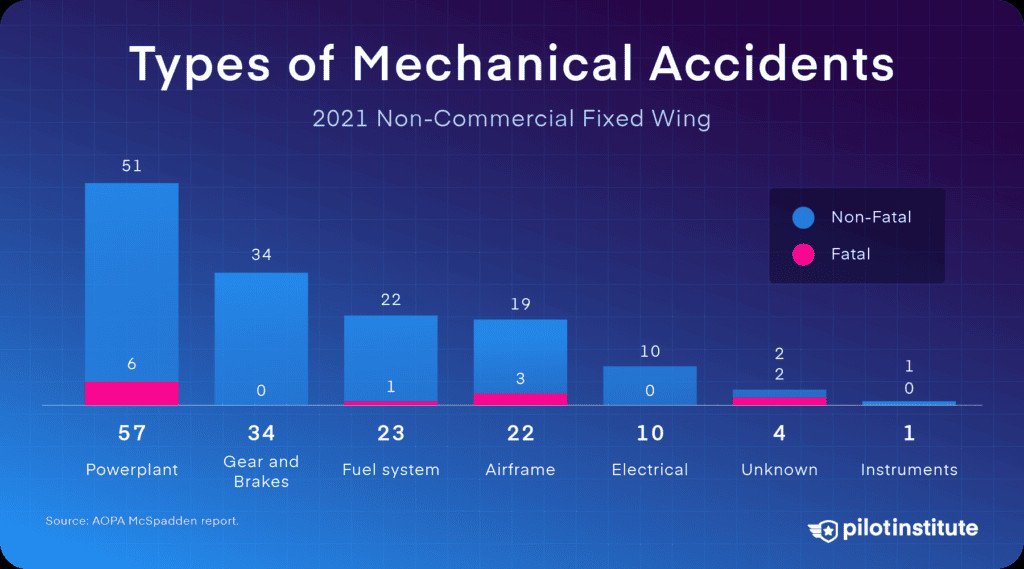 Types of GA mechanical accidents
Types of GA mechanical accidents
19. How Does Aircraft Maintenance Contribute to Flight Safety?
Proper aircraft maintenance is essential for ensuring the safe operation of an aircraft. Regular inspections, timely repairs, and adherence to maintenance schedules can prevent mechanical failures and reduce the risk of accidents.
Aircraft owners should follow the manufacturer’s recommended maintenance schedule and address any identified issues promptly. Use qualified mechanics for all maintenance and repairs, and maintain detailed records of all work performed. A well-maintained aircraft is more reliable and less likely to experience mechanical failures, contributing to safer flights.
20. What Role Does Technology Play in Improving Aviation Safety?
Technology plays a crucial role in improving aviation safety through advancements in navigation, communication, and aircraft systems. GPS, terrain awareness systems, and enhanced weather radar can help pilots maintain situational awareness and avoid hazards.
Advanced avionics systems can provide real-time information about aircraft performance, weather conditions, and surrounding traffic. Enhanced communication systems allow pilots to communicate with air traffic control and other pilots, improving coordination and safety. Autopilot systems can assist pilots in maintaining control of the aircraft, especially in challenging conditions. By leveraging technology, pilots can enhance their capabilities and improve overall safety.
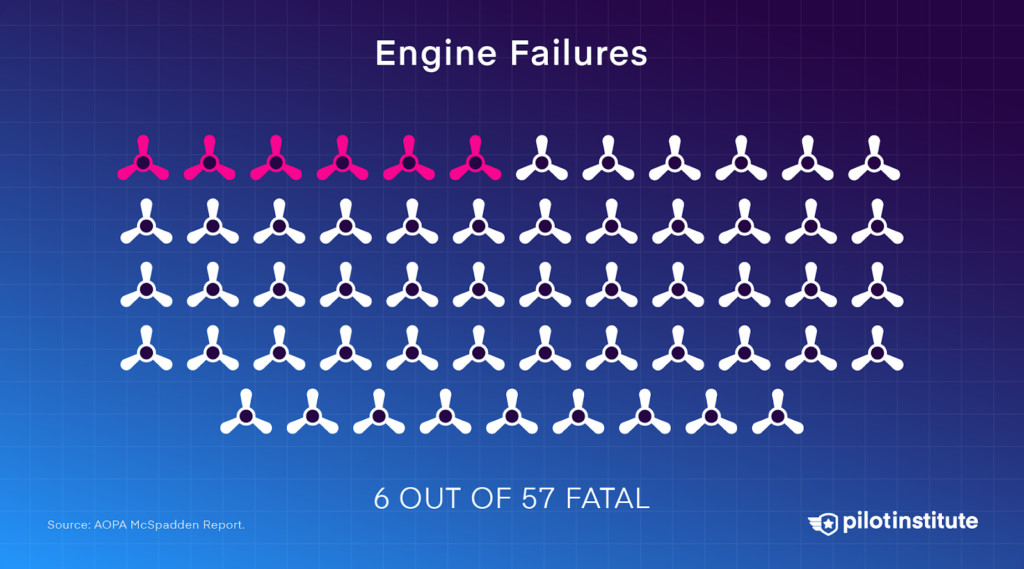 Six out of 57 engine failure accidents in 2021 were fatal
Six out of 57 engine failure accidents in 2021 were fatal
21. What Is the Importance of a Flight Safety Culture in General Aviation?
A flight safety culture promotes a proactive approach to safety, encouraging pilots and aviation professionals to prioritize safety in all aspects of flight operations.
A strong flight safety culture involves open communication, transparency, and a willingness to learn from mistakes. Pilots should feel comfortable reporting safety concerns without fear of reprisal. Aviation organizations should promote a culture of continuous improvement, encouraging pilots and staff to identify and address potential hazards. By fostering a strong flight safety culture, the aviation community can create a safer environment for all.
22. How Can General Aviation Pilots Ensure They Are Proficient?
General aviation pilots can ensure they are proficient by flying regularly, practicing maneuvers, participating in flight reviews, and seeking additional training.
Proficiency is more than just meeting the minimum legal requirements for flight. It involves maintaining a high level of skill and knowledge through continuous practice and training. Pilots should fly regularly to maintain their skills and stay familiar with their aircraft. Practicing maneuvers, such as stalls, spins, and emergency procedures, can help pilots develop the muscle memory and quick reflexes needed to respond effectively in challenging situations. Participating in flight reviews and seeking additional training can provide valuable feedback and help pilots identify areas for improvement.
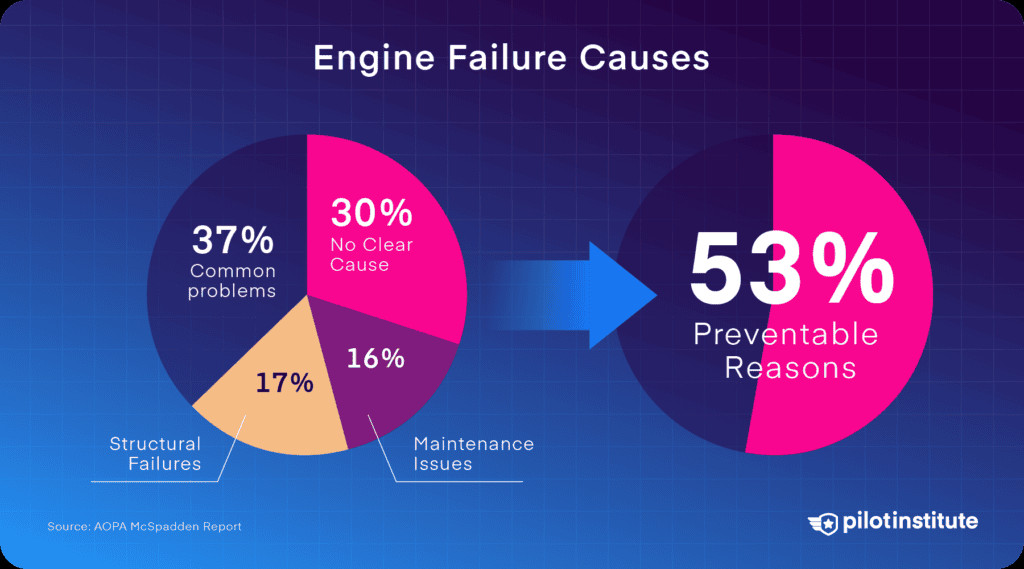 A diagram depicting the reasons for engine failures
A diagram depicting the reasons for engine failures
23. What Are the Legal Requirements for Maintaining Pilot Currency in the US?
In the United States, the legal requirements for maintaining pilot currency include completing a flight review every 24 calendar months, performing three takeoffs and landings in the same category and class of aircraft within the preceding 90 days to carry passengers, and meeting specific night flying requirements to carry passengers at night.
These requirements are outlined in the Federal Aviation Regulations (FARs) and are designed to ensure that pilots maintain a minimum level of proficiency. However, currency is not the same as proficiency. Pilots should strive to exceed these minimum requirements and maintain a high level of skill and knowledge.
24. How Can Pilots Stay Updated on the Latest Aviation Safety Information?
Pilots can stay updated on the latest aviation safety information by subscribing to aviation publications, attending safety seminars, and monitoring websites such as the FAA Safety Team (FAASTeam) and the AOPA Air Safety Institute.
Aviation publications, such as Aviation Safety magazine and Flight Safety Digest, provide valuable information about accidents, incidents, and safety best practices. Attending safety seminars and webinars can help pilots stay current on the latest regulations, procedures, and technologies. Monitoring websites such as the FAASTeam and the AOPA Air Safety Institute can provide access to a wealth of safety resources, including accident analysis reports, safety videos, and online courses.
 Types of GA fuel management accidents
Types of GA fuel management accidents
25. What Are the Potential Consequences of Neglecting Aviation Safety?
Neglecting aviation safety can have severe consequences, including accidents, injuries, fatalities, and legal repercussions.
Aviation accidents can result in significant damage to aircraft, property, and the environment. They can also cause serious injuries or fatalities for pilots, passengers, and people on the ground. In addition to the physical and emotional toll, neglecting aviation safety can lead to legal consequences, including fines, suspension of pilot certificates, and criminal charges. Prioritizing aviation safety is essential for protecting lives and property and ensuring the continued viability of the aviation industry.
26. Is Flying Getting Safer Over Time?
Generally, yes, flying has become safer over time due to advancements in technology, training, and regulations. However, constant vigilance and continuous improvement are necessary to maintain and further enhance safety.
Commercial aviation has seen a significant reduction in accident rates over the past several decades, thanks to improvements in aircraft design, air traffic control systems, and pilot training. General aviation has also seen some improvements in safety, but progress has been slower. By continuing to invest in safety research, technology, and training, the aviation community can make flying even safer in the future.
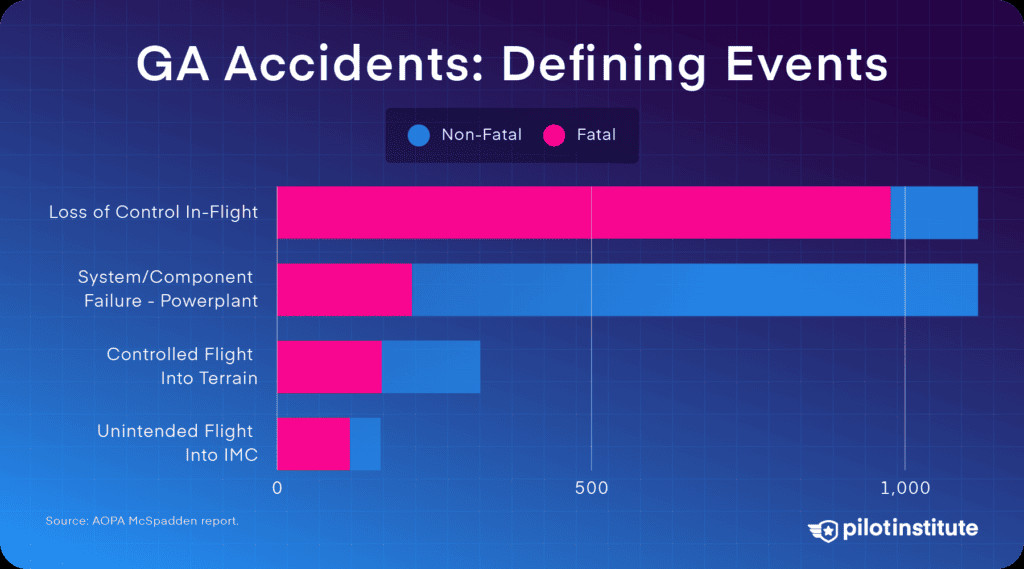 A selection of GA accident defining events
A selection of GA accident defining events
27. How Does Commercial Aviation Achieve Such High Safety Levels?
Commercial aviation achieves high safety levels through rigorous training, strict regulations, advanced technology, and a strong safety culture.
Commercial airlines invest heavily in pilot training, requiring pilots to undergo extensive ground school, simulator training, and flight training. Commercial aviation is subject to strict regulations enforced by government agencies such as the FAA. Commercial aircraft are equipped with advanced technology, such as GPS, autopilot systems, and enhanced weather radar. Commercial airlines promote a strong safety culture, encouraging pilots and other employees to prioritize safety in all aspects of flight operations.
28. What Can General Aviation Learn From Commercial Aviation?
General aviation can learn from commercial aviation by adopting a more structured approach to training, implementing stricter maintenance standards, and fostering a stronger safety culture.
General aviation pilots can benefit from more formalized training programs, including scenario-based training and recurrent training. General aviation aircraft owners can improve safety by adhering to stricter maintenance standards and ensuring that their aircraft are properly maintained. The general aviation community can foster a stronger safety culture by promoting open communication, transparency, and a willingness to learn from mistakes.
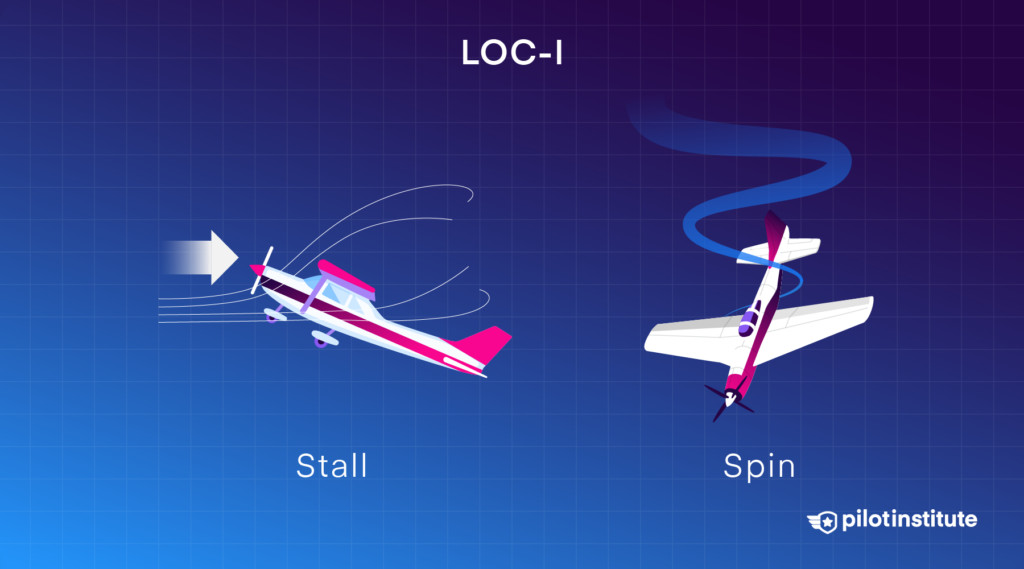 Loss of Control In-Flight: the leading cause of fatal accidents
Loss of Control In-Flight: the leading cause of fatal accidents
29. How Do International Regulations Affect Aviation Safety?
International regulations, such as those established by the International Civil Aviation Organization (ICAO), play a crucial role in ensuring consistent safety standards across different countries.
ICAO develops and promotes international standards and recommended practices (SARPs) for aviation safety, security, and efficiency. These SARPs are adopted by member states and incorporated into their national regulations. By adhering to international regulations, countries can ensure that their aviation systems meet a minimum level of safety and that flights operating across borders are conducted safely.
30. What Future Trends Are Expected to Impact Aviation Safety?
Future trends that are expected to impact aviation safety include the increasing use of drones, the development of autonomous aircraft, and the growing demand for air travel.
The increasing use of drones presents new challenges for aviation safety, including the risk of collisions with manned aircraft and the potential for misuse. The development of autonomous aircraft raises questions about pilot training, certification, and liability. The growing demand for air travel could strain existing infrastructure and resources, potentially leading to increased congestion and safety risks. Addressing these future trends will require innovative solutions, collaboration, and a continued commitment to safety.
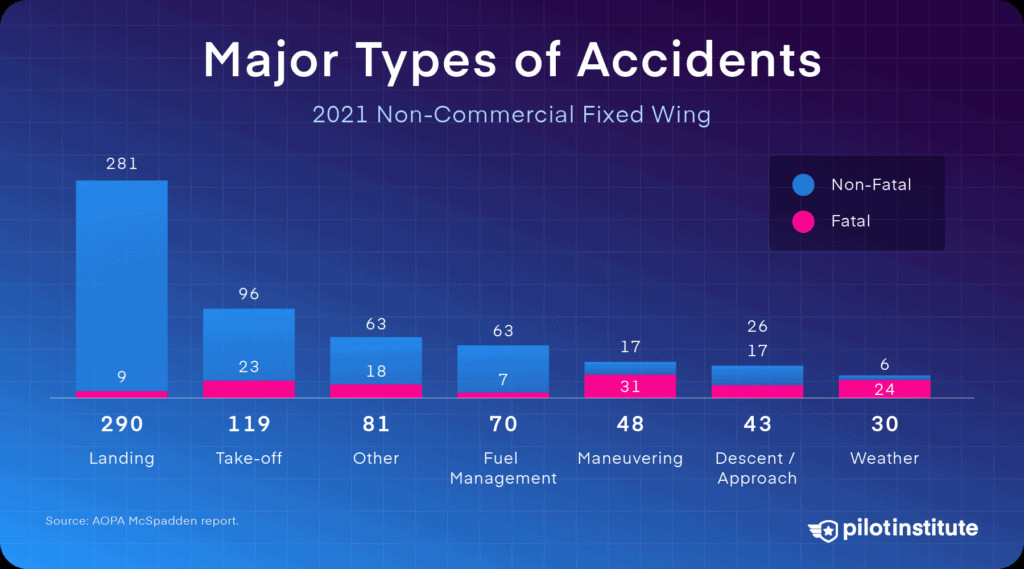 Major types of GA accidents
Major types of GA accidents
31. What Role Does the FAA Play in Aviation Safety?
The FAA plays a central role in aviation safety by regulating air commerce, setting standards for aircraft maintenance and operation, and licensing pilots and aviation personnel.
The FAA’s mission is to provide the safest, most efficient aerospace system in the world. The FAA enforces regulations, conducts inspections, and investigates accidents to ensure that aviation operations are conducted safely. The FAA also works to promote aviation safety through education, outreach, and the development of new technologies.
32. How Can Pilots Prepare for Emergencies in Flight?
Pilots can prepare for emergencies in flight by practicing emergency procedures, maintaining situational awareness, and using checklists.
Pilots should regularly practice emergency procedures, such as engine failure, fire, and loss of control. Maintaining situational awareness involves knowing the aircraft’s position, altitude, and surrounding terrain. Checklists can help pilots systematically respond to emergencies and ensure that all critical steps are taken. By preparing for emergencies, pilots can increase their chances of a successful outcome.
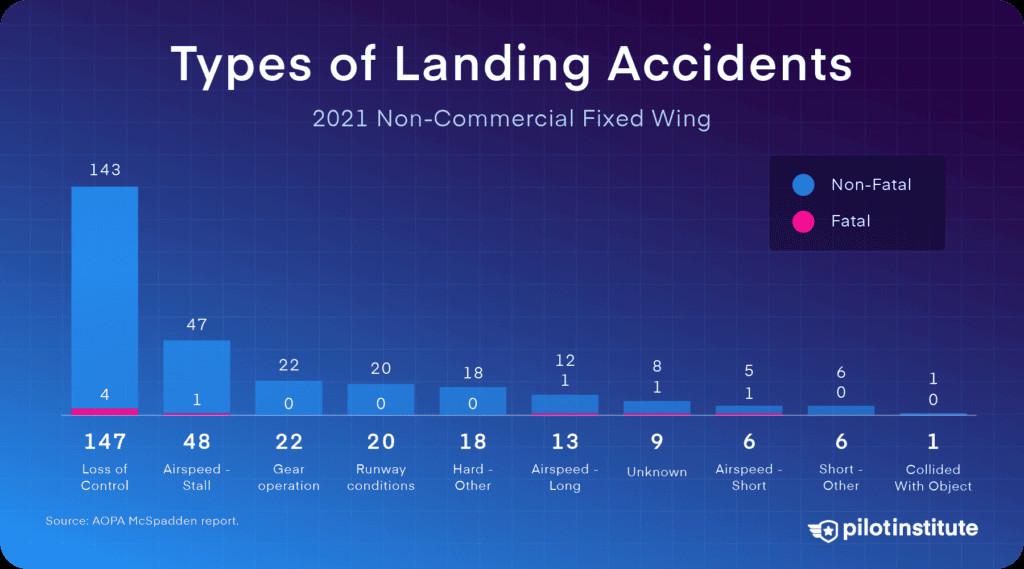 Types of GA landing accidents
Types of GA landing accidents
33. What Are the Most Common Mistakes Made During Landing?
Common mistakes made during landing include improper airspeed control, poor alignment with the runway, and failure to execute a go-around when necessary.
Maintaining proper airspeed is crucial for a safe landing. Flying too fast or too slow can make it difficult to control the aircraft and increase the risk of a hard landing. Poor alignment with the runway can lead to a side load on the landing gear, which can cause the aircraft to veer off the runway. If the landing is not going as planned, pilots should execute a go-around and try again.
34. How Important Is Pre-Flight Weather Briefing for Pilots?
A pre-flight weather briefing is extremely important for pilots as it provides critical information about current and forecast weather conditions that could impact the safety of the flight.
Weather can change rapidly, and pilots need to be aware of potential hazards, such as thunderstorms, icing, turbulence, and low visibility. A thorough weather briefing will provide information about these hazards and help pilots make informed decisions about whether to fly, the route to take, and the altitude to fly at.
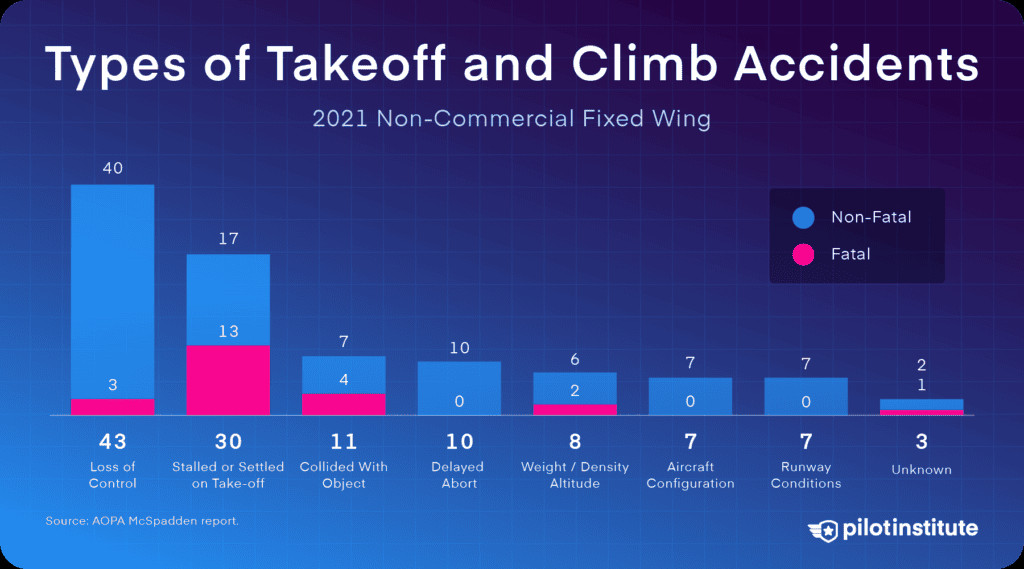 Types of GA takeoff and climb accidents
Types of GA takeoff and climb accidents
35. How Does Fatigue Affect Pilot Performance?
Fatigue can significantly impair pilot performance, leading to reduced alertness, impaired decision-making, and slower reaction times.
Fatigue can result from various factors, including lack of sleep, stress, and prolonged periods of alertness. Pilots should get adequate rest before each flight, avoid stressful situations, and take breaks when needed. Recognizing the symptoms of fatigue and taking steps to mitigate its effects is crucial for maintaining flight safety.
36. What Are the Best Practices for Night Flying?
Best practices for night flying include being familiar with the airport and surrounding terrain, using appropriate lighting, and maintaining situational awareness.
Night flying can be more challenging than daytime flying due to reduced visibility. Pilots should be thoroughly familiar with the airport and surrounding terrain before flying at night. Using appropriate lighting, such as runway lights and taxiway lights, can help pilots see the runway and taxiways clearly. Maintaining situational awareness is crucial for avoiding obstacles and other hazards.
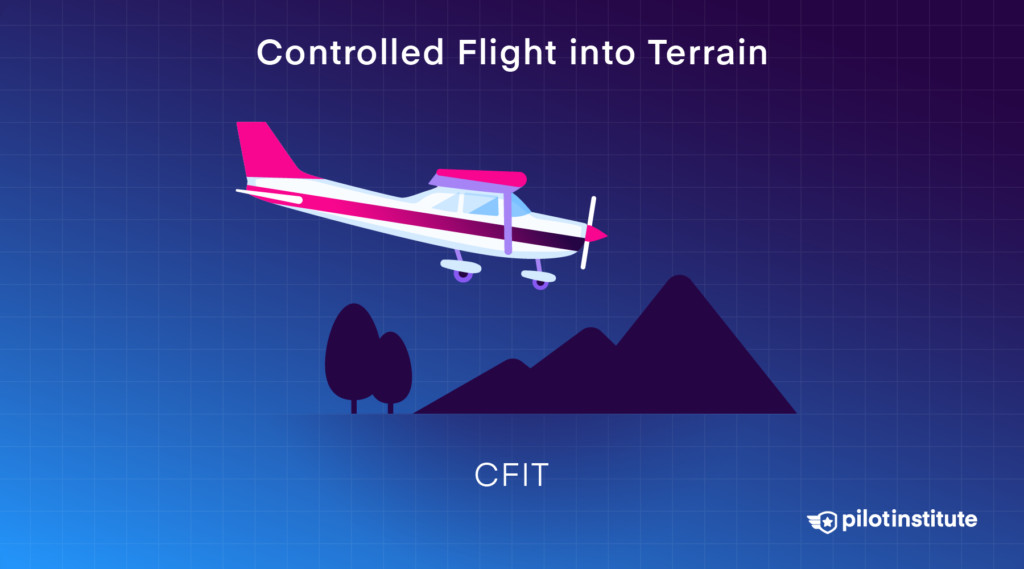 Controlled Flight into Terrain: a top cause of fatal accidents
Controlled Flight into Terrain: a top cause of fatal accidents
37. How Can the Use of Checklists Improve Flight Safety?
The use of checklists can improve flight safety by ensuring that all critical tasks are performed correctly and in the proper sequence.
Checklists provide a standardized procedure for performing tasks, reducing the risk of errors and omissions. Pilots should use checklists for pre-flight inspections, engine start-up, takeoff, landing, and emergency procedures. By using checklists, pilots can improve their efficiency and accuracy, and reduce the risk of accidents.
38. What Is the “Sterile Cockpit” Rule, and Why Is It Important?
The “sterile cockpit” rule prohibits non-essential activities during critical phases of flight, such as takeoff and landing.
The sterile cockpit rule is designed to minimize distractions and allow pilots to focus on flying the aircraft. Non-essential activities, such as conversations, eating, and using electronic devices, are prohibited during these phases of flight. By adhering to the sterile cockpit rule, pilots can reduce the risk of errors and improve flight safety.
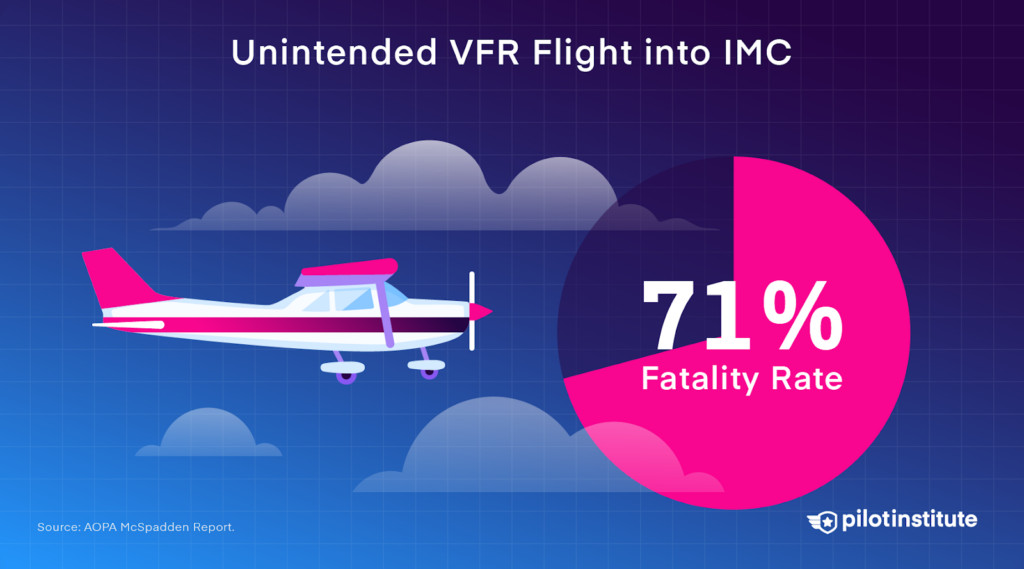 Unintended VFR flight into IMC has a 71% fatality rate
Unintended VFR flight into IMC has a 71% fatality rate
39. What Are the Key Considerations for Flying in Mountainous Terrain?
Key considerations for flying in mountainous terrain include understanding wind patterns, altitude, and terrain clearance.
Wind patterns can be complex and unpredictable in mountainous terrain, with updrafts, downdrafts, and turbulence. Pilots need to be aware of these wind patterns and adjust their flight accordingly. Maintaining adequate altitude is crucial for ensuring terrain clearance. Pilots should use topographical maps and GPS to stay aware of their position and altitude.
40. How Does Carbon Monoxide (CO) Poisoning Affect Pilots, and How Can It Be Prevented?
Carbon monoxide (CO) poisoning can impair pilot performance by reducing the ability of the blood to carry oxygen.
CO is a colorless, odorless gas produced by the combustion of fuel. Leaks in the exhaust system can allow CO to enter the cockpit, leading to CO poisoning. Symptoms of CO poisoning include headache, dizziness, and nausea. Pilots can prevent CO poisoning by ensuring that their aircraft is equipped with a CO detector and by maintaining the exhaust system.
For those passionate about aviation, whether you’re dreaming of becoming a pilot, are a seasoned aviator, or simply love the world of flight, flyermedia.net offers a wealth of information. Explore our site for training programs, aviation news, and career opportunities, and take your aviation journey to new heights. If you have any questions or need assistance, contact us at Address: 600 S Clyde Morris Blvd, Daytona Beach, FL 32114, United States, Phone: +1 (386) 226-6000, or visit our website: flyermedia.net.
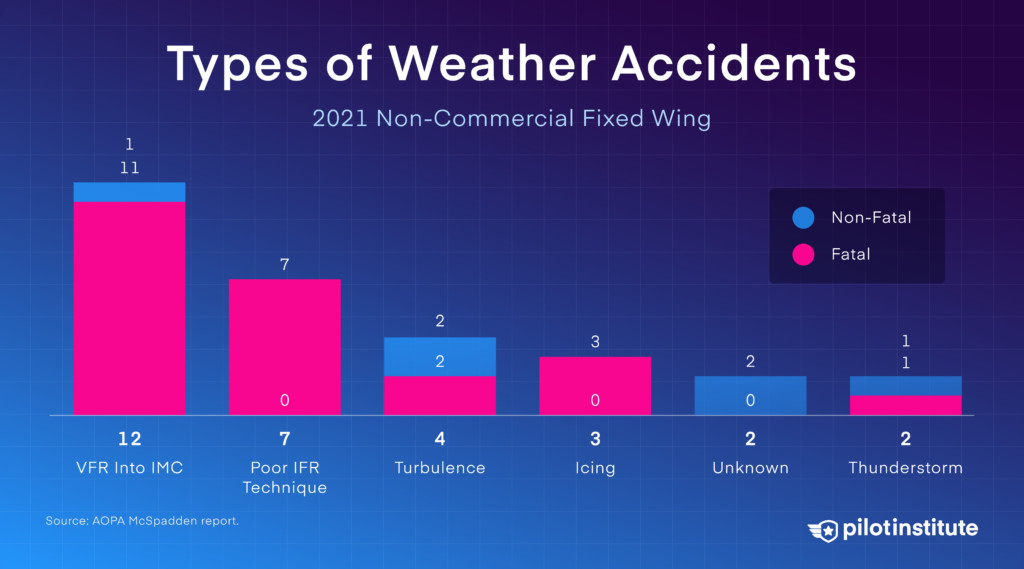 Types of GA weather accidents
Types of GA weather accidents
FAQ: Is Flying Really Safer Than Driving?
1. Is flying safer than driving?
Commercial airline travel is significantly safer than driving, but general aviation has a higher accident rate than driving.
2. What makes commercial flying so safe?
Commercial aviation’s safety is attributed to rigorous training, strict regulations, advanced technology, and a strong safety culture.
3. What is general aviation (GA)?
General aviation includes all flying activities except commercial airlines and military operations, encompassing private planes and personal flights.
4. Why are personal GA flights riskier than commercial flights?
Personal GA flights have less stringent regulations, varying pilot experience, and diverse aircraft maintenance standards, contributing to a higher accident rate.
5. What is the leading cause of accidents in general aviation?
Pilot error is the primary cause, including loss of control in-flight, poor decision-making, and inadequate flight planning.
6. How do mechanical failures contribute to GA accidents?
Mechanical failures are the second most common cause, including engine failures, fuel system issues, and structural failures.
7. How can pilots reduce mechanical-related accidents?
Pilots can conduct thorough pre-flight inspections, ensure regular maintenance, and practice proper fuel management to prevent mechanical issues.
8. What is Loss of Control In-flight (LOC-I)?
LOC-I is when a pilot loses the ability to maintain the desired flight path, often leading to severe accidents.
9. What safety measures can improve GA safety?
Implementing structured operations, rigorous training, proficiency, and risk management can significantly improve GA safety.
10. What resources are available for GA pilots to improve safety?
Resources include the FAA Safety Team (FAASTeam), AOPA Air Safety Institute, and flyermedia.net, which offer safety seminars, accident analysis, and training materials.
